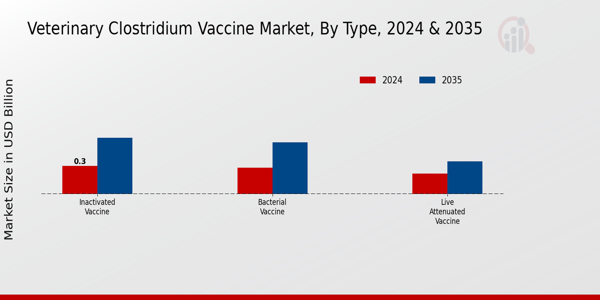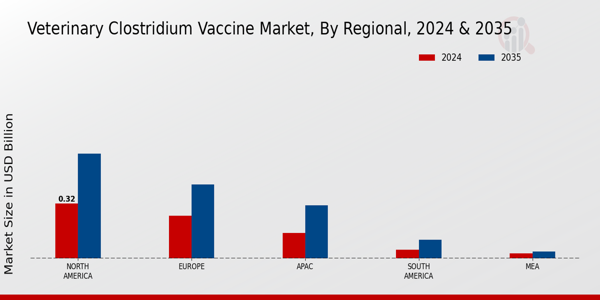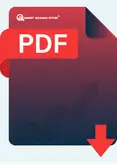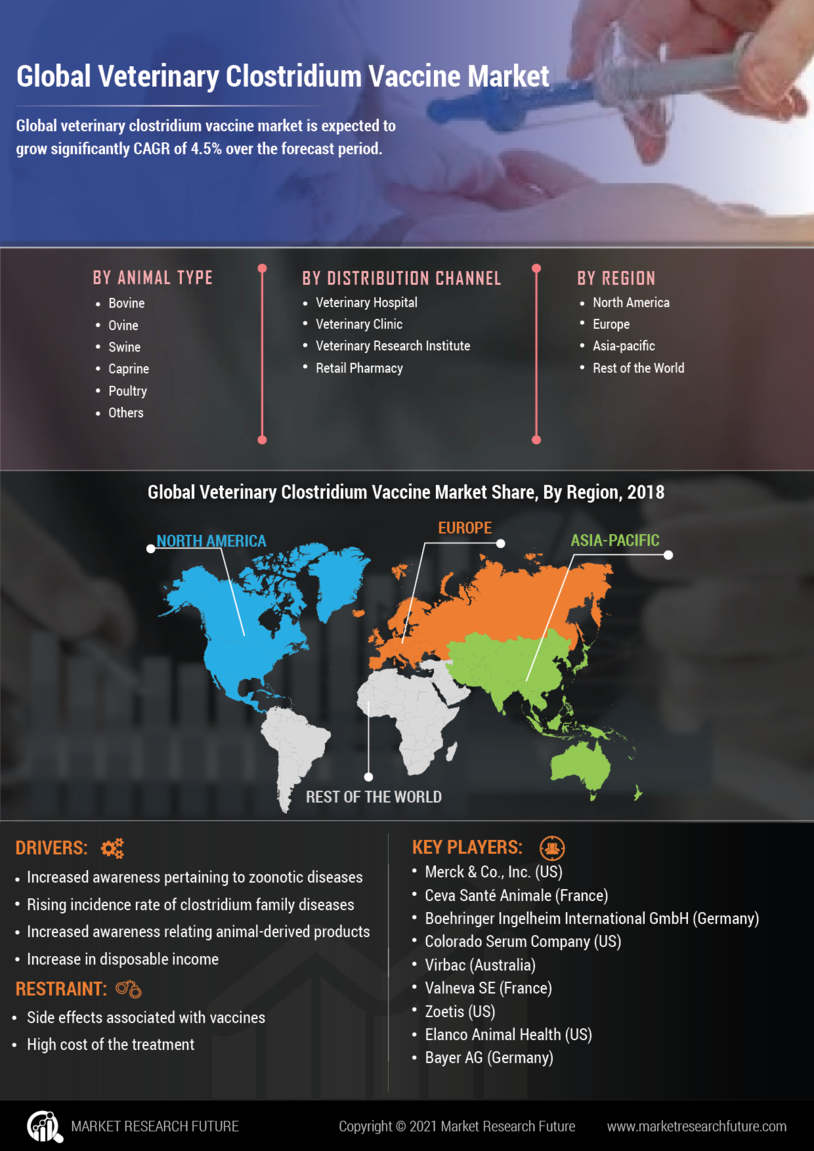Veterinary Clostridium Vaccine Market Overview
As per MRFR analysis, the Veterinary Clostridium Vaccine Market Size was estimated at 0.75 (USD Billion) in 2023.The Veterinary Clostridium Vaccine Market Industry is expected to grow from 0.8(USD Billion) in 2024 to 1.5 (USD Billion) by 2035. The Veterinary Clostridium Vaccine Market CAGR (growth rate) is expected to be around 5.89% during the forecast period (2025 - 2035).
Key Veterinary Clostridium Vaccine Market Trends Highlighted
The Global Veterinary Clostridium Vaccine Market is growing rapidly with the incidence of clostridial infections along with concerns regarding animal health. The livestock population is growing which increases the demand for vaccines and also enhances productivity and welfare to animals. The market for Clostridium vaccines is increasingly becoming important as farmers and pet owners realize the importance of vaccination in preventing diseases. Innovative technologies aimed toward developing safer and more effective vaccines are further boosting growth. Additional production infrastructure coupled with investment for R&D for novel vaccine technologies provides growth opportunities in the market.
There is significant growth potential in emerging markets that are less developed, with active livestock industries, and little awareness of vaccination. There is a gap in the vocational effort to publicize campaigns and promote vaccination to the public aimed at improving animal healthcare that leads to collaboration with governments to improve public health and veterinary pharmacy companies. An eco-friendly approach aimed globally toward health and the environment has recently emerged on vaccination that further enhances these frameworks.
Also, these trends increase the risk of contracting diseases from animals, widely known as zoonotic diseases, which boosts the demand for preventative vaccines, thereby enhancing the need for the vaccines.
Telemedicine and health monitoring devices are examples of digital technologies being integrated within animal healthcare. This alters how veterinary care is offered and how vaccines are given and tracked. In sum, the Global Veterinary Clostridium Vaccine Market is being driven by persistent growth sustained by shifting consumer needs, alongside progression in veterinary medicine.

Veterinary Clostridium Vaccine Market Drivers
Increase in Livestock Populations
The Global Veterinary Clostridium Vaccine Market Industry is significantly driven by the increasing livestock populations worldwide. According to the Food and Agriculture Organization, it was reported that the global livestock population has grown to approximately 1.5 billion cattle and over 600 million sheep as of recent years.
As livestock populations grow, the risk of Clostridium infections in these animals increases, necessitating the use of vaccines for prevention.Established organizations, such as the World Organisation for Animal Health, advocate for vaccination as a pivotal strategy in managing the health of livestock, highlighting that vaccination not only protects individual animals but also enhances overall herd health, leading to increased productivity in meat and dairy production.
Growing Awareness of Animal Health
There has been a substantial increase in awareness regarding animal health and welfare globally, which is substantially promoting the Global Veterinary Clostridium Vaccine Market Industry. Recent surveys by the International Federation for Animal Health indicate that about 60% of pet owners and livestock breeders have become more conscious of vaccinations and preventative healthcare for their animals.
This increase in awareness drives demand for Clostridium vaccines, as more animal owners are seeking to prevent diseases rather than treat them.Organizations like the World Veterinary Association contribute to this growing awareness by promoting educational campaigns about the importance of vaccinations, thereby influencing farmers and pet owners to invest in vaccine solutions for Clostridium-related health issues.
Technological Advancements in Vaccine Development
Technological advancements in vaccine development are also propelling the Global Veterinary Clostridium Vaccine Market Industry forward. The last decade has seen significant progress in biotechnology and Research and Development processes that enable the creation of more effective and safer vaccines. For instance, the adoption of recombinant DNA technology and improved adjuvant formulations have led to vaccines that provide longer-lasting immunity and reduce adverse reactions in animals.Research from various veterinary institutes shows that vaccine efficacy has improved by approximately 30% due to these advancements.
Organizations such as the United Nations’ Food and Agriculture Organization are collaborating with leading veterinary pharmaceutical companies to promote innovation in vaccine technology, which is crucial for maintaining livestock health and production stability.
Veterinary Clostridium Vaccine Market Segment Insights
Veterinary Clostridium Vaccine Market Type Insights
The Global Veterinary Clostridium Vaccine Market is experiencing notable growth, reflected through its evolving Type segmentation. With the overall market valued at 0.8 USD Billion in 2024, this growth trajectory is anticipated to reach 1.5 USD Billion by 2035, showcasing an expanding demand for veterinary vaccines globally.
Among the types, the Bacterial Vaccine segment demonstrates a significant presence, holding a valuation of 0.28 USD Billion in 2024 and projected to grow to 0.55 USD Billion in 2035, indicating a major share within the total market.This is primarily driven by increasing livestock farming and the necessity for disease prevention among animals to ensure food safety and security on a global scale.
Furthermore, the Inactivated Vaccine segment is also crucial with a valuation of 0.3 USD Billion in 2024, which is expected to reach 0.6 USD Billion by 2035. Its importance lies in the growing veterinary care awareness and the need to protect against a broader range of infectious diseases through effective immunization strategies. Meanwhile, the Live Attenuated Vaccine segment, while smaller, shows noteworthy developments with a valuation of 0.22 USD Billion in 2024 and a potential increase to 0.35 USD Billion by 2035.
This segment often dominates the market in certain geographical regions due to its proven effectiveness in stimulating strong immune responses in livestock, making it a preferred choice among veterinarians. The market trends also reflect a surge in technological advancements and Research and Development activities aimed at enhancing vaccine efficacy and safety, contributing to stronger market growth.
As veterinary health regulations become more stringent globally, the demand for these vaccines will continue to rise, driven by the vital role they play in animal health and public safety.The Global Veterinary Clostridium Vaccine Market statistics indicate a robust platform for market players to innovate and respond to the growing challenges in animal health.

Veterinary Clostridium Vaccine Market Target Animal Insights
The Global Veterinary Clostridium Vaccine Market poised for growth, with a valuation of USD 0.8 billion in 2024 and a projected growth reaching USD 1.5 billion by 2035. The segment focused on Target Animals represents a significant part of this market, encompassing key categories such as Cattle, Sheep, Pigs, and Goats. The demand for Clostridium vaccines is driven by increasing livestock farming to meet the global protein demand and the growing awareness regarding animal health.
Cattle play an essential role in dairy and beef production, contributing to the majority holding in market dynamics.Sheep and Goats are sought after for meat and wool production, while Pigs are significant contributors to global meat consumption.
Each of these animals requires tailored vaccination strategies to manage clostridial diseases effectively, making their health a priority for livestock owners. This increasing focus on health management is accentuated by rising investments in veterinary healthcare and advancements in vaccine technologies. The Global Veterinary Clostridium Vaccine Market is witnessing strong growth due to these factors, fostering favorable conditions for the development of effective vaccines across various target animal segments.
Veterinary Clostridium Vaccine Market Distribution Channel Insights
The Global Veterinary Clostridium Vaccine Market showcases a diverse landscape in its Distribution Channel segment, crucial for ensuring that these vital vaccines reach end-users effectively. In 2024, the market achieved a valuation of 0.8 billion USD, reflecting a steady demand across various distribution methods. Veterinary clinics play a pivotal role in this market, providing direct access to veterinarians who administer the vaccines, thereby maintaining a strong influence on market dynamics. Online pharmacies have also gained traction, appealing to a tech-savvy demographic seeking convenience and reliability in purchasing veterinary products.
Distributors act as intermediaries that manage supply chains and ensure product availability across different regions, hence holding a significant position in the market. Retail pharmacies further complement the distribution landscape by catering to pet owners directly, thus increasing accessibility to these vaccines. As consumer behaviors evolve, particularly with the rise in e-commerce, the Online Pharmacies segment is expected to become increasingly significant.
Furthermore, the Global Veterinary Clostridium Vaccine Market statistics indicate that this market is driven by the rising awareness of animal health and preventative care, while challenges such as regulatory compliance and distribution logistics persist.Opportunities abound as more efficient supply chain solutions emerge, bolstering the revenue potential across all distribution channels.
Veterinary Clostridium Vaccine Market End Use Insights
The Global Veterinary Clostridium Vaccine Market shows significant potential as it serves various end-use segments, primarily comprising Livestock Farming, Pet Care, and Research Institutions. In 2024, the overall market was valued at 0.8 billion USD, demonstrating its increasing relevance in the animal health sector. Livestock Farming dominates this market segment as a key driver, given the necessity for vaccination to prevent Clostridium infections in livestock, which can lead to severe economic losses.
Similarly, Pet Care is witnessing growth due to the rising pet ownership trends and the growing awareness about animal health, thereby emphasizing the importance of vaccines in maintaining the well-being of companion animals.
Research Institutions also play a pivotal role in advancing vaccine development and enhancing preventive measures against Clostridium diseases. Since 2025, a consistent CAGR of 5.89 percent is anticipated for the overall market, reflecting a robust growth trajectory fueled by emerging technologies in veterinary healthcare. This market growth is driven by factors such as increased investment in animal health, regulatory advancements, and the urgent need to prevent outbreak-related losses in both livestock and domestic pets.
Veterinary Clostridium Vaccine Market Regional Insights
The Global Veterinary Clostridium Vaccine Market is set to provide a comprehensive revenue stream across various regions. North America hold a majority share, valued at 0.32 USD Billion in 2024, and is projected to reach 0.61 USD Billion by 2035, showcasing its significant role in the market. In Europe, the valuation starts at 0.25 USD Billion in 2024 and climbs to 0.43 USD Billion by 2035, indicating a solid adoption of vaccines in livestock.
The APAC region, while smaller, exhibits growth potential, moving from 0.15 USD Billion in 2024 to 0.31 USD Billion by 2035, highlighting increasing awareness and livestock management.South America and MEA trail with 0.05 USD Billion and 0.03 USD Billion in 2024, respectively, escalating to 0.11 USD Billion and 0.04 USD Billion by 2035. These regions are gradually improving their veterinary health infrastructure, suggesting opportunities for growth. The increasing prevalence of clostridial diseases among livestock, along with growing investments in animal health, are key drivers for the market across these regions.
As a result, the Global Veterinary Clostridium Vaccine Market segmentation reveals a varied landscape that is well-poised for growth in response to rising demands for effective veterinary care.

Veterinary Clostridium Vaccine Market Key Players and Competitive Insights
The Global Veterinary Clostridium Vaccine Market is characterized by a diverse range of players vying for dominance through technological advancements, product innovation, and strategic partnerships. The market is primarily driven by the rising prevalence of Clostridium-associated diseases in livestock and companion animals, necessitating effective vaccination solutions. Competitive insights reveal a landscape where companies are increasingly focusing on research and development to enhance vaccine efficacy and safety. Furthermore, regulatory compliance and market access strategies play crucial roles in shaping competitive positioning, as companies strive to meet stringent global health standards while adapting to the unique needs of regional markets.
The focus on expanding distribution channels and improving veterinary healthcare services is also becoming integral to maintaining competitiveness within this dynamic sector.Huvepharma has established a significant presence in the Global Veterinary Clostridium Vaccine Market, leveraging its robust product portfolio and extensive distribution network. The company's strength lies in its focus on animal health, where it emphasizes the development of vaccines that are both effective and safe for use across various animal species. Huvepharma’s commitment to innovation is evident in its investment in research and development, which aims to address emerging health challenges linked to Clostridium pathogens.
This proactive approach allows Huvepharma to respond swiftly to market demands and adapt its offerings according to evolving veterinary needs. Additionally, the company's strategic collaborations and partnerships enhance its visibility and operational capabilities in the global landscape, further cementing its competitive edge in the industry.Vetoquinol is a prominent player in the Global Veterinary Clostridium Vaccine Market, known for its strong dedication to animal health and welfare.
The company provides a range of veterinary vaccines aimed at preventing Clostridium infections in livestock and pets, showcasing its expertise in the field. Vetoquinol’s strengths include a well-established brand reputation and a commitment to quality, which resonate with veterinary professionals globally. Furthermore, the company's focus on researching novel vaccine formulations underscores its proactive stance in tackling emerging health issues. Through strategic mergers and acquisitions, Vetoquinol has expanded its market presence and streamlined its operations, allowing for greater efficiency and enhanced product offerings.
This approach not only strengthens its position in the veterinary sector but also solidifies its ongoing commitment to advancing veterinary medicine on a global scale.
Key Companies in the Veterinary Clostridium Vaccine Market Include
- Qingdao Dabeinong Technology Group
Veterinary Clostridium Vaccine Market Industry Developments
Recent developments in the Global Veterinary Clostridium Vaccine Market have highlighted a growing demand for effective vaccination strategies to combat clostridial diseases in livestock and pets. Key players such as Huvepharma, Merck Animal Health, and Zoetis are increasingly focusing on Research and Development to enhance vaccine efficacy and broaden the spectrum of protection. In August 2023, Vetoquinol announced the launch of a new Clostridium vaccine aimed at improving immunological responses in cattle, an indication of rising competition in this segment.
Moreover, in June 2023, IDT Biologika expanded its production capabilities to meet increasing global demand, reflecting its commitment to the market. There have also been notable mergers and acquisitions, such as Boehringer Ingelheim's acquisition of Merial in 2016, which has provided a solid foundation for advancing vaccine technologies.
The market valuation for veterinary vaccines has surged, driven by an increase in animal health awareness and government initiatives promoting livestock health globally. This growth is expected to continue, particularly as emerging challenges related to animal diseases prompt a need for better vaccination solutions across various regions. Over recent years, the emphasis on preventive healthcare in livestock and companion animals has notably intensified, with substantial investments being funneled into vaccine development and deployment.
Veterinary Clostridium Vaccine Market Segmentation Insights
Veterinary Clostridium Vaccine Market Type Outlook
Veterinary Clostridium Vaccine Market Target Animal Outlook
Veterinary Clostridium Vaccine Market Distribution Channel Outlook
Veterinary Clostridium Vaccine Market End Use Outlook
Veterinary Clostridium Vaccine Market Regional Outlook
- North America
- Europe
- South America
- Asia Pacific
- Middle East and Africa
| Report Attribute/Metric Source: |
Details |
| MARKET SIZE 2023 |
0.75(USD Billion) |
| MARKET SIZE 2024 |
0.8(USD Billion) |
| MARKET SIZE 2035 |
1.5(USD Billion) |
| COMPOUND ANNUAL GROWTH RATE (CAGR) |
5.89% (2025 - 2035) |
| REPORT COVERAGE |
Revenue Forecast, Competitive Landscape, Growth Factors, and Trends |
| BASE YEAR |
2024 |
| MARKET FORECAST PERIOD |
2025 - 2035 |
| HISTORICAL DATA |
2019 - 2024 |
| MARKET FORECAST UNITS |
USD Billion |
| KEY COMPANIES PROFILED |
Huvepharma, Vetoquinol, IDT Biologika, Merck Animal Health, Virbac, Phibro Animal Health, JBL GmbH, Boehringer Ingelheim, Neogen, Merial, Elanco Animal Health, Zoetis, Cegelec, Qingdao Dabeinong Technology Group |
| SEGMENTS COVERED |
Type, Target Animal, Distribution Channel, End Use, Regional |
| KEY MARKET OPPORTUNITIES |
Increase in pet ownership, Rising livestock production, Growing awareness of zoonotic diseases, Advancements in vaccine technology, Expansion into emerging markets |
| KEY MARKET DYNAMICS |
Increasing animal health awareness, Rising livestock population, Advancements in vaccine technology, Growing demand for meat products, Government support for veterinary care |
| COUNTRIES COVERED |
North America, Europe, APAC, South America, MEA |
Veterinary Clostridium Vaccine Market Highlights:
Frequently Asked Questions (FAQ):
The Global Veterinary Clostridium Vaccine Market is expected to be valued at 0.8 USD Billion in 2024.
By 2035, the Global Veterinary Clostridium Vaccine Market is projected to reach a value of 1.5 USD Billion.
The expected CAGR for the Global Veterinary Clostridium Vaccine Market from 2025 to 2035 is 5.89%.
North America is expected to hold the largest market share in the Global Veterinary Clostridium Vaccine Market, valued at 0.32 USD Billion in 2024.
The projected market value of the Veterinary Clostridium Vaccine in Europe by 2035 is 0.43 USD Billion.
Key players in the market include Huvepharma, Merck Animal Health, and Zoetis among others.
The market size for Bacterial Vaccines in 2024 is valued at 0.28 USD Billion.
The market for Inactivated Vaccines is expected to reach 0.6 USD Billion by 2035.
The APAC region is projected to grow to a market size of 0.31 USD Billion by 2035.
Emerging trends include increasing vaccine development and rising awareness about animal health.


















